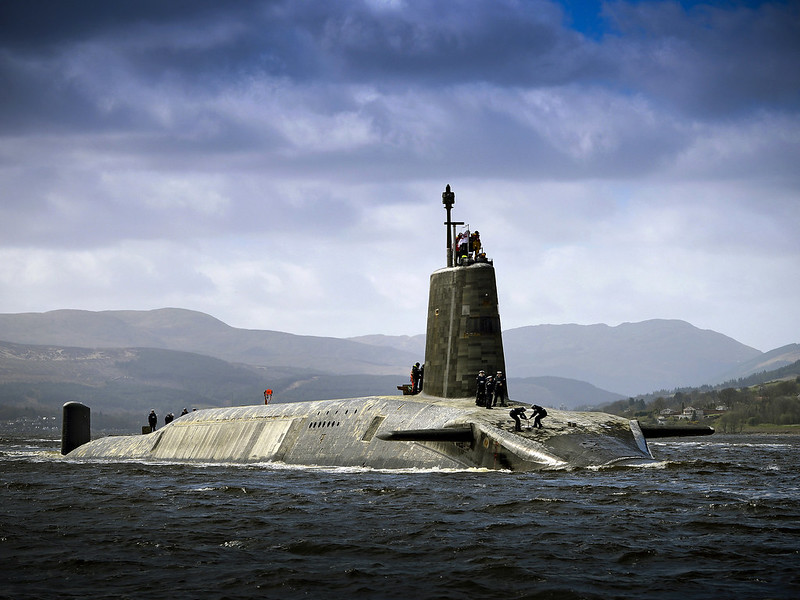
The United Kingdom relies exclusively on submarine launched ballistic missiles for their nuclear deterrent. They have no land-based missiles (ICBMs) or bomber delivered nuclear weapons.
In 2011 the speculation was they had 225 nuclear warheads. Of these, 160 were operationally available with 65 spares to allow for routine maintenance and processing.
Information for this post is primarily from the Bulletin of the Atomic Scientists, volume 67, published in 2011: British nuclear forces, 2011.
England has 50 Trident II D5 missiles, which were purchased from the United States. This variation can carry up to 12 reentry vehicles. Common understanding is the British have three nuclear weapons on each missile. There is a mixture of Mk4 and Mk4A reentry vehicles with the Mk4A variation having updated capabilities.
Each reentry vehicle has one weapon which is described as comparable to the US W76 warhead.
My previous research shows the W76-1 has a yield of 90 kt. The newest W76-2 has a far lower yield of around 5 kt. The -2 variation is only being deployed by the United States sometime in 2020 as I understand, so the British SSBNs were armed with 90 kt weapons in 2011 and presumably still are today.
For comparison purposes, megaton equivalent of a nuclear weapon is calculated as megaton raised to the two-thirds power, or mt^(2/3). Thus the 90 kt W76 has 0.2o megaton equivalent (0.090 ^ (2/3) = .2008). The 5 kt W76-2 has 0.03 megaton equivalent (.005 ^ (2/3) = .0292). The 90 kt is about 7 times as powerful as the 5 kt variation (.201 / .029 = 6.87).
Vanguard class submarine
The British have four Vanguard class ballistic missile submarines, or SSBNs. Their names are:
- Vanguard, launched 1992 (lead boat in a class carries the name of the class)
- Victorious, launched 1993
- Vigilant, launched 1996
- Vengeance, launched 1998
Availability of these four, according to the article, is:
- one is always at sea on “continuous at sea deterrent”
- two are available on short notice; I will make a wild guess that means available in several days or perhaps a week or so
- one is in overhaul or extended maintenance and therefore would not be available for quite some time
The Boomer on deployment is on “reduced alert.” You can imagine what this means since the article says they would not be able to launch for several days. I can make guesses as to what that means for their configuration, but will not do so.
The Vanguard class boomers have 16 launch tubes.
Standard loadout
Article says the standard loadout is for all 16 tubes to carry a Trident II missile, each of them carrying an average of three reentry vehicles each loaded with equivalent of a W76 warhead. That works out to be 48 warheads at sea at all times, loaded on 16 missiles.
The 2011 article said an announced change of policy is that at some point thereafter the boomers will be loaded with eight missiles and 40 weapons. This made an average of five warheads per missile.
Read one article which said the loadout of 40 nukes on 8 missiles was implemented in 2015.
Let’s do so math on potential loads.
- Capacity of 16 tubes times maximum load of 12 reentry vehicles each equals 192 warheads maximum on one SSBN.
- At the 2011 configuration of 3 RVs on 16 Tridents means 48 missiles at sea. Deploying the two additional boomers would mean 144 RVs total. Completing maintenance on the fourth sub and deploying her would mean 192 at sea.
- Fully deployment of all four subs at the 2015 loadout of 40 RVs each would be 160 nukes at sea.
Weapons in inventory
In 2011 it was announced that England had 225 weapons and were going to reduce that to 180 or less in about 15 years, or the mid-2020s.
Article indicates that previous guesses of the total inventory in the 1970s was about 350 warheads. Additional information led the authors to speculate that there were probably something in the range of 520 warheads back then.
Earlier post indicated that England currently has 190 weapons and had previously planned to reduce that to 180 in the next few years. Instead, they’re going to increase the target to 260, an increase of 70 over the current inventory.